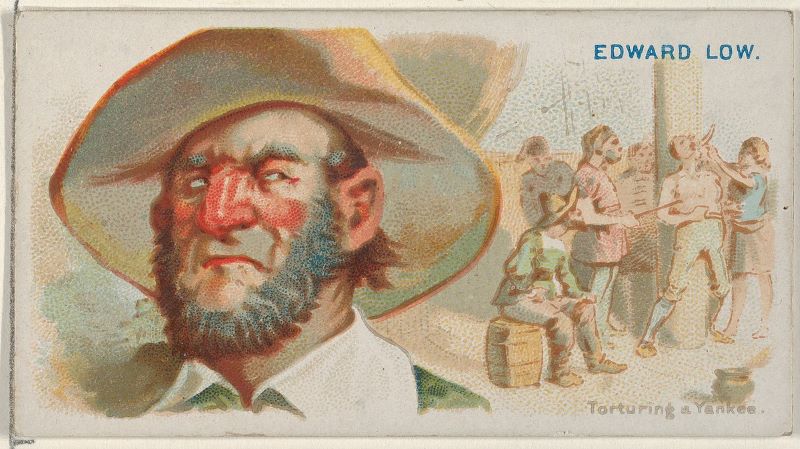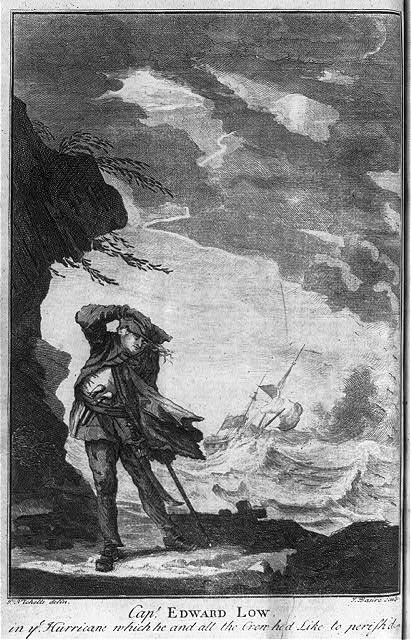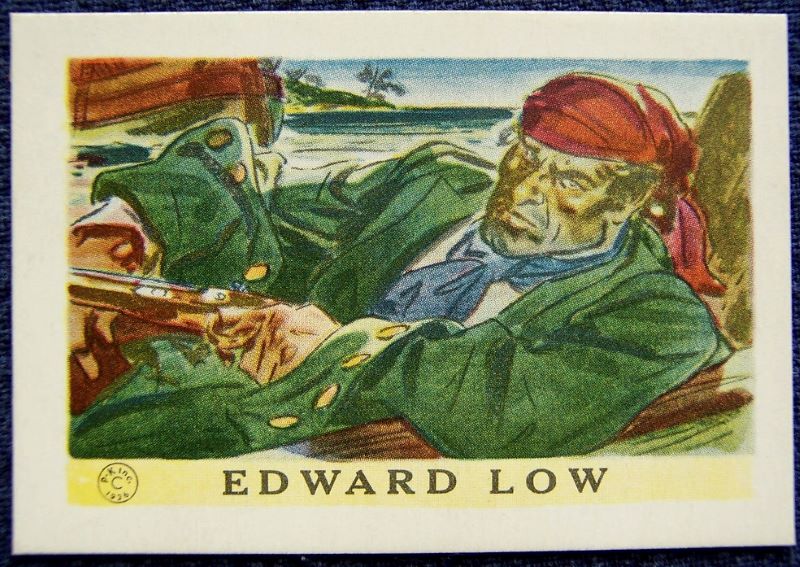Edward “Ned” Low was an English-born pirate who later moved to Boston, Mass in his youth.
Low was born into poverty in Westminster, London in 1690 and later became a common thief who would pickpocket in the streets of Westminster.
One of Low’s brothers was also reportedly a pickpocket, thief and burglar who was later hanged for his crimes (Dow 141.)
In 1710, Low left England and went to sea with his brother where he visited many major seaports before eventually reaching Boston, Mass about three years later.
It was in Boston where Low fell in love with a young woman named Eliza Marble.
On August 12, 1714, Low married Marble at the First Church in Boston and had a son, who died in infancy, and then a daughter in the winter of 1719.
Unfortunately, shortly after the birth of his daughter, his wife Eliza died, leaving Low in a state of sorrow.
Low, who was known for being arrogant and quarrelsome, was fired by his employer for some reason shortly after his wife’s death and he decided to leave Boston.
Leaving his daughter behind in Boston, Low found work as a ship rigger on a sloop bound for the Bay of Honduras. When the sloop reached the bay, Low was appointed to command the crew that went ashore to get a cargo of logwood and bring it back to the vessel.
At the time, Honduras was Spanish territory and the log wood was being cut without permission so the boat’s crew of 12 men went ashore fully armed in case of any conflict with the Spanish.
One day, the crew returned hungry and tired with a cargo of log wood and asked to stay on board the ship to eat dinner but the captain ordered them back out to finish loading the ship.
Angry, Low pulled his pistol and fired at the captain but missed and hit a sailor standing behind him. Low then jumped in the boat with its crew of 12 men and made off from the ship.
Low Becomes a Pirate:
The men decided to capture a small sloop shortly after and Low was elected captain as they made their way for the Cayman islands.
Upon reaching the islands, Low and his men ran into another pirate, Captain George Lowther, who was in need of more men for his crew. Lowther proposed that the two groups join forces and that Low serve as his lieutenant.
Low and his men agreed and they sank the small vessel they had previously captured and sailed off together in Lowther’s ship the Happy Delivery.
On January 10, 1722, the pirates came across their first victim when they entered the Bay of Honduras and saw the ship the Greyhound of Boston, which was commanded by Captain Benjamin Edwards.
The pirates attacked the ship, boarded it and looted it while they whipped and beat the crew and eventually forced five of them, Christopher Atwell, Charles Harris, Henry Smith, Joseph Willis and David Lindsay, to join their pirate crew.

Lowther soon went on to capture several other ships such as a sloop from Connecticut, a sloop from Jamaica, a sloop from Virginia and a sloop from Rhode Island which was given to Edward Low to command.
In early May of 1722, the pirates sailed near the island of Discade in the West Indies where they captured, plundered and sank a brigantine.
On May 28, they captured a brigantine named Rebecca from Charlestown, Mass, commanded by James Flucker, which was bound for Boston with 23 people on board including five women.
The passengers, including the women, were all reportedly treated well while the ship made its way to Boston where the pirates promised to return the brigantine to the captain after they captured a better ship (Dow 146.)
By this point, Lowther had found Low to be an unruly lieutenant and decided to rid himself of him by offering the brigantine to Low along with a crew of 40 men, which Low accepted.
Low’s first attack with the brigantine came in August when he captured and robbed a sloop off the coast of Rhode Island and then captured and robbed another sloop, commanded by James Cahoon. He let both ships go but not before cutting down their rigging and throwing it overboard.
In search of fresh water, Low then sailed north to Buzzard’s Bay where he remained for a few days while his crew stole sheep at No Man’s Land and plundered Nantucket whale boats.
Originally planning to sail to the Bahamas, Low changed his mind and continued to sail north until he reached Nova Scotia and pulled into Port Roseway on Friday, June 15, 1722.
Pulling into the harbor, he saw a number of fishing vessels anchored in the harbor and captured nearly a dozen of them that afternoon and evening.
Low plundered the ships and forced 10 of the fishermen, including Philip Ashton of Marblehead, Nicholas Merrit, Joseph Libbie, Lawrence Fabbans and two others from Marblehead and four men from the Isle of Shoals, to join his pirate crew.
Philip Ashton, who later wrote an account of his capture titled Ashton’s Memorial: An History of the Strange Adventures, and Signal Deliverances, of Mr. Philip Ashton, stated that Low first demanded to know if any of the men were married as he did not want married men on his crew:
“It seems his design was to take no married man away with him, how young so ever he might be, which I often wondered at; till after I had been with him some considerable time, and could observe in him an uneasiness in the sentiments of his mind, and the workings of his passions towards a young child he had at Boston (his wife being dead, as I learned, some small time before he turned pirate) which upon every lucid interval from revelling and drink he would express a great tenderness for, in so much that I have seen him sit down and weep plentifully upon the mentioning of it; and then I concluded, the probably the reason of his taking none but single men was, that he might have none with him under the influence of such powerful attractives, as a wife & children, lest they should grow uneasy in his service, and have an inclination to desert him, and return home for the sake of their families” (Barnard 3.)
On Tuesday, June 19, 1722, Low and his fleet set sail and on July 2 arrived at the mouth of St. John’s Harbor where they spotted a British man-of-war named the Solebay and managed to escape before being discovered.
The pirates then went to a small harbor farther north called Carbonear where they went ashore and plundered the place and then burned all the houses.
The following day, Low attacked six or seven vessels at the Grand Banks and forced a number of the fisherman to join his crew.
Around the same time, Low discovered that the Solebay was looking for him so he sailed for the Leeward Islands but ran into a hurricane along the way which damaged some of the ships in his fleet.

After the storm, Low went to one of the small islands in the westernmost section of the Caribbean to gather supplies and trade goods with the natives.
Low then sailed east and, on August 3, 1722, reached St. Michael’s where they captured seven ships, including a French ship named the Nostra Dame, the Mere de Dieu, the Dove, the Rose, a man-of-war captained by Captain Thompson, an English ship captained by Captain Chandler and three other vessels.
In need of fresh water and provisions, Low sent word to the governor of St. Michael’s that if he gave them the supplies they needed Low would release the vessels he had captured. The governor gave in and supplied them with provisions after which Low released six vessels.
A few weeks later, on August 20, the fleet came across a schooner called the Wright, captained by Captain Carter, and captured it. The crew onboard were beaten, tortured and some were killed.
When one of the passengers was being beaten, Low was accidentally struck on the jaw during the attack which caused a wound so bad that it required stitches but Low became angry with the surgeon doing the stitches and punched him.
After the drunken crew grew tired of beating the passengers and plundering the ship, they cut down the sails and set the ship adrift.
Low then sailed for the Cape Verde islands and captured an English ship called the Liverpool Merchant, near Bonavista, from which they stole provisions, dry goods and brandy and forced six of the men to join their crew.
In addition, they also captured a British ship captained by Andrew Scot called King Sagamore, forced several of the crew to join them and sent the captain and the remaining crew ashore naked while they burned the ship.
The pirates then captured two Portuguese sloops and three sloops from St. Thomas, all of which were plundered and set free.
Around the same time, they also captured a small English trading sloop commanded by Captain James Pease, and placed a number of their forced crew on board to manage it.
On September 5, 1722, after the forced men had been looking for a way to escape for a while, they mutinied against the captain on the English sloop, took over the ship and sailed off.
After the loss of the English sloop and its crew, Low went to the island of Bonavista to careen his ship and then went to the island of St. Nicholas for freshwater. It was at the southeast end of St. Nicholas that they captured a sloop from Barbados, the Margaret, captained by George Roberts.
The pirates then set sail for the coast of Brazil hoping to capture some more Portuguese ships. Not finding much luck there, they headed for the West Indies where they captured a large sloop near the French island of Grenada.
Low went on to capture seven or eight more sloops and a Portuguese ship called the Nostra Signiora de Victoria. When the captain threw a bag containing nearly £15,000 into the sea instead of handing it over to the pirates, Low tortured him and then murdered him and the crew of 32 men.
On January 25, 1723, the pirates captured a snow, a large two-masted ship, called Unity from New York and forced two of the crew to join them and also captured another snow from London carrying a cargo of wine.
Other ships Low captured at this time include a sloop from the Bay of Honduras bound for New York, a sloop from Curacao, and the pink Stanhope captained by Andrew Delbridge from Boston, which Low burned.
Near the island of Santa Cruz, Low captured two French sloops but let them go when they provided him with his request of a new medicine chest.
Setting sail for Curacao, Low chased two sloops which managed to evade him. He then accidentally began chasing a British man-of-war who eventually recognized Low’s ship as a pirate ship and began chasing him instead.
Low’s fleet of two ships split up in order to lose the man-of-war which they successfully did after one of them forced it aground by leading it straight into an uncharted shoal.
The two pirates ships were separated for nearly five weeks when they finally caught sight of each other but failed to recognize each other and began firing at the other. It wasn’t until one of the ship’s raised their pirate flag that they realized their mistake.
The next day, the two ships stopped at Roatan harbor to careen and clean the bottom of their ships. On Saturday, March 9, 1723, some of the crew were heading to the island to gather freshwater when they allowed forced crewmen Philip Ashton to join them at his request.
It was here that Ashton made his escape from the pirates, by pretending to look for coconuts inland and then hiding in the woods, and then lived the next 16 months as a castaway on the island before finally being rescued by a convoy of merchant ships.
In May of 1723, Low attacked a Spanish privateer that had just captured and plundered a fleet of New England ships in the Bay of Honduras. Low killed all of the Spanish privateers and released their captives.
In late May of 1723, Low reached the coast of South Carolina where he captured four ships, the Crown, the King William, the Carteret and a New England ship called the Amsterdam Merchant which was commanded by Captain John Welland.
It’s been reported that Low hated New Englanders and this hatred became apparent when he decided to cut off one of Captain Welland’s ears, slit his nose and cut up several other parts of his body. He then plundered the ship and sank it.
Low then captured and plundered a ship commanded by Captain Estwick of Piscataqua the following day but set it free after and allowed Captain Welland to leave with the ship.
In early June, Low captured the sloop Hopefull Betty off the shore of Delaware and tortured the captain but eventually released him.
On June 10, 1723, a New York man-of-war, the Greyhound, had discovered the pirates whereabouts and tracked them down and engaged in a battle with the pirate fleet.
During the fight, Low realized they had little chance of defeating the ship and fled, leaving behind his other vessel, the Ranger, captained by Charles Harris. Harris and his crew were quickly captured and brought on board the Greyhound as prisoners.
Two days later, Low took out his rage at this loss on a sloop from Nantucket when he captured it and stripped, whipped and cut off the ears of the captain, Nathan Skiff, before shooting him in the head and sinking his ship and forcing some of his crew to join him.
Two days after that, Low attacked a fishing boat near Block Island and decapitated the captain and then attacked two whaling sloops near Rhode Island later that afternoon.
It is reported that Low cut out the heart of one of the sloop’s captains and forced his crew member to eat it and then cut off the ears of the other captain and forced his crew member to eat them (Dow 209.)
Low then sailed north to Newfoundland and reportedly captured 23 French fishing vessels and then captured another 18 ships soon after.
Towards the end of July, 1723, Low captured a large ship from Virginia, the Merry Christmas, and made her his flagship. Low assumed the new title of Admiral and hoisted his new flag on the topmast: a black flag with a red skeleton on it.
Low then sailed for the western islands and reached Fayal where he captured an English brigantine that was owned by a Portuguese nobleman.
Arriving soon after in St. Michael’s, Low captured a English ship captained by Captain Thomas, whom Low had captured there the year before, and cut off the captain’s ears and burned the ship.
Low then sailed to the Cape Verde islands and then on to the coast of Guinea in the fall of 1723 where he captured a schooner and then a ship called the Delight which Low added to his fleet.
At this point, Low’s fleet consisted of the ship Merry Christmas, which was commanded by Low, the sloop Happy Delivery, commanded by Captain Lowther, and the Delight, commanded by Captain Spriggs. Together they set sail for the West Indies.
What Happened to Edward Low?
In January of 1724, it is known that Low captured a ship called the Squirrel but what became of Low after this point in time is unclear.
In March of 1724, news reached Boston that Low reportedly had a fight with some other pirates who burned his vessel and marooned him on a deserted island.
This story was repeated again in the spring of 1726 when Captain William Cross of Piscataqua, NH returned from the Bay of Honduras and said that both Low and Spriggs had been marooned on an island but escaped with some Mosquito Indians.
On May 17, 1726, some sailors returned from Barbados and said that Low had captured their ship near St. Lucia and released them. They also stated that a French man-of-war was in pursuit of Low and it may have possibly captured him.
Another account from a French source stated that back in the spring of 1724, Low’s crew had mutinied against him after he killed his quartermaster and set him adrift in a boat after which he was captured by the French man-of-war and taken back to France where he was tried and hanged.
This account was later confirmed by a crewmen, Jonathan Barlow, who was captured by Low on the ship Merry Christmas and stated that the pirates mutinied against Low on a French sloop they had captured.
It isn’t clear which of these many stories is true though and Low’s fate remains unknown to this day.
Sources:
Dow, George Francis and John Henry Edmonds. The Pirates of the New England Coast 1630 – 1730. Dover Publications, 2012.
Barnard, John. Ashton’s Memorial: An History of the Strange Adventures, and Signal Deliverances, of Mr. Philip Ashton. Boston, N.E. Printed for Samuel Gerrish, at his Shop in Corn-Hill, 1725.



I was following up on my ancestory and came upon this. It was very interesting.
Lowe is on my father’s side. My grandmother on my mother’ side was an Atkins
from the Boston area. Thank-you.